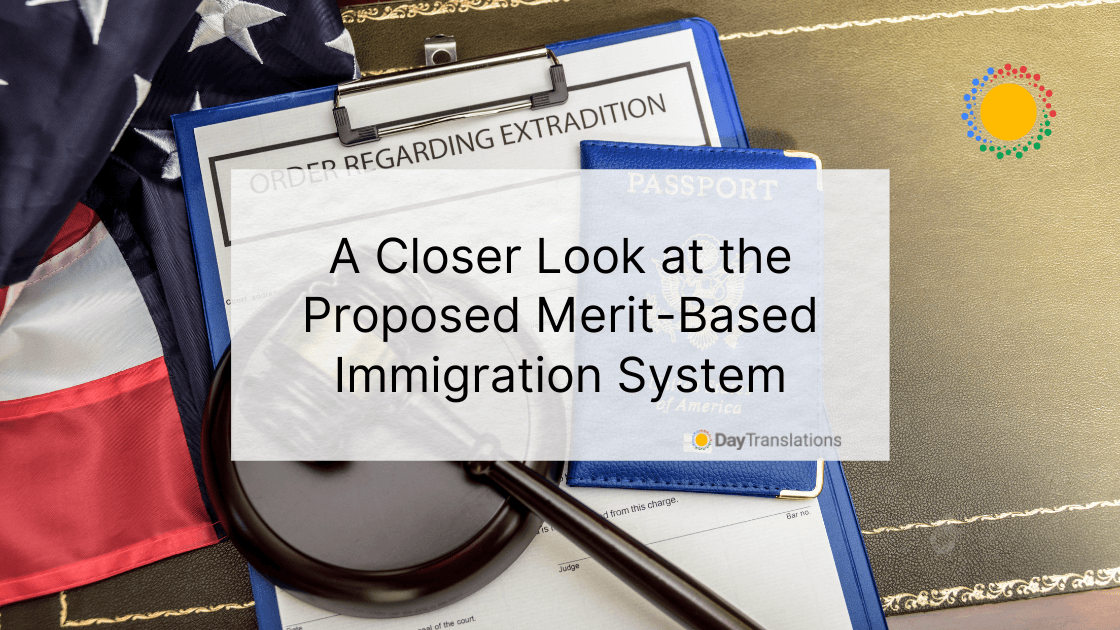U.S. President Trump always expressed his intention to curb immigration during his presidential campaign, and started with the institution of the travel ban in an effort to dissuade illegal immigrants. Next up is the merit-based immigration system.
There are still thousands of undocumented immigrants in the United States, and fearing a crackdown on these undocumented foreigners, various communities defied the order and provided shelter for them.
It is a fact that the United States needs immigrants, especially for agricultural areas. However, the Trump administration wants to limit immigration and choose the people who could be more economically helpful to the U.S.
Therefore, the government is now looking closer into the implementation of a merit-based immigration system, which is similar to what Australia and Canada impose.
Related Post: Certified Translation is Required for U.S. Immigration Documents
Looking Back at the Issue
The merit-based immigration system of Canada and Australia prioritize skilled immigrants. Both countries use a system of points. The U. S. president believes that the points system would give taxpayers huge savings and increase the wages of earlier immigrants and native Americans.
This is a technocratic approach, meaning immigrants that could contribute more to the U.S. economy would have a higher chance of being issued a visa.
Current Status
The U.S. immigration system right now annually grants legal permanent residence status or green cards to about one million foreign-born individuals. Four main methods are used for this purpose: humanitarian reasons, green-card lottery selection, job offer from an employer in the U.S. and family sponsorship.
Most of the green cards are awarded each year via family ties with relatives who are already residents of the United States. Green cards via employment are only about 14 percent of the annual total, which are roughly about 140,000.
There are also many people who enter the U.S. on temporary visas. They also influence the economy. About half of the people granted green cards are already in the country, having transitioned from holding temporary visas to being permanent residents.
This is a very important factor because the selection process for people granted temporary visas is different from the process of granting permanent residency.
In 2016, the breakdown of some of the temporary visas is as follows:
- Students (F & M visas) – 513,000
- Workers (with job offers and their dependents) (H & L visas) – 700,000
- Exchange visitors (many of them working) (J visas) – 380,120
It should be noted that most of the work-related temporary visas are usually issued for unskilled workers (quite different from a merit-based immigration system). Temporary visa holders also qualify for a family-based green card if they get married to a U.S. citizen or permanent resident.
Based on the purpose of the visa categories, the skill mix of people coming to the U.S. is influenced by the U.S. government. However, it is not the government that chooses the persons entering the country within the visa categories.
For work-related visas, the employers play a direct role in selecting the immigrants. The employers could submit applications for H-1B temporary work visas for college degree holders. There are 85,000 reserved visas for this category. When it is not filled up for the year, the excess is used in the visa lottery.
Related Post: How Immigration Changes the World – Is It Good or Bad?
The Points System
If a country imposes the points system (the merit-based immigration system), it comes up with a set of desirable characteristics from immigration applicants. These are weighed by assigning different points for each category. There will be a threshold number for the total point tally. Priority is given to applicants whose total points go beyond the threshold.
Australia, Canada and New Zealand have used the merit-based immigration system for many years. The United Kingdom also adopted the system recently. With the merit-based immigration system, immigration is favorable to applicants with higher experience and education.
However, it should be noted that even countries that admit immigrants via the merit-based immigration system also use other systems. Canada for example, admits immigrants for humanitarian reasons and also because of family ties.
The impact of the points system rests on the scope of the system as well as the standards that would be used for the points.
If the U.S. were to introduce the merit-based immigration system, the impact would be bigger if the scope of the employment-based category is to be expanded, instead of just applying it to those temporary visas and green cards that are already based on employment.
One major advantage of the points system or the merit-based immigration system is its ability to select immigrants who have chances to earn more, thus contribute more to the country’s economy.
In Canada, there is concrete evidence that immigrants who came to the country via the points system do have higher education. Their earnings and employment rates are also higher than other immigrants.
But there are is some evidence that points to the fact that those selected via the Canadian points system did not perform well in the labor market. Even if they have college degrees, they only earn wages that are given to high-school graduates. They are not innovative, compared to those college-educated immigrants entering the U.S.
No study has been done to understand the reason for this. But there is the possibility that it has something to do with how employers make the selection.
This could be surmised by the amendments the countries using the merit-based immigration system for immigration have done to their system, prioritizing applicants who have the potential to be productive, those who are carefully selected by employers and those whose scores are above the threshold points.
Proposed Merit-Based Immigration System
If the current Senate bill passes without change, the merit-based immigration system will be enacted after five years. Green cards would be rewarded based on the foreign immigrant’s educations, work history, skills, English language skills and ties to U.S. citizens.
They would also be considered based on their country of origin, business activities and other qualities, such as community service. The proposal for merit-based immigration system provides the availability of 120,000 visas annually. Depending on the demand, the number could increase to a maximum of 250, 000 visas each year.
During the initial four years after the enactment of the merit-based visa system, based on the current proposal, the number of visa allocation would supplement the EB-3 visa allocation so the backlog that exists for third preference employment-related petitions could be eliminated.
It would only be on the fifth year after the bill has been approved that the merit-based visa allocation would be opened to immigration applicants who already have approved or pending petitions under the family-based or employment-based categories.
Related Post: The Repercussions of The New Immigration Policy of President Trump
Availability and Allocation of Visas
There are two tiers on the proposed merit-based immigration system:
- Tier 1 – for higher skilled workers
- Tier 2 – for medium and lower skilled workers
On the fifth year after the bill’s enactment (based on the current proposal), the allocation for visas will be equally divided between the two tiers. Unused visas will be added to the current year, again divided between the two.
In terms of numbers, the allocation is going to be based on these conditions:
- If the national employment rate remained steady or go under 8.5 percent and the demand for merit-based visas for the fiscal year is lower than 75 percent, next year’s visa allocation would go higher by 5 percent.
- If the unemployment rate across the county goes over 8.5 percent or the demand for merit-based visas reached 75 percent or more, there would be no increase in the next year.
The suggested fee for a merit-based immigration system visa is $500.
Merit-Based Immigration System in Detail
Under the proposed Reforming American Immigration for Strong Employment Act (RAISE Act) authored by Senators Cotton (R-Arkansas) and Perdue (R-Georgia), the government should implement a merit-based immigration system.
This act would require an alien applicant to gain points based primarily on work experience, education and family ties. Green cards would be awarded to those alien applicants who receive the highest points overall.
Tier 1 category has a maximum of 100 points, broken down into the following:
- Education
PhD = 15 points
Master’s = 10 points
Bachelor’s = 5 points
Note: A PhD will not have additional points for his/her bachelor’s and master’s degrees.
- Employment (based on O*Net Job Zones)
- An alien applicant gains 3 points/year if he/she is lawfully employed in an O*Net Job Zone 5 occupation in the U.S. The alien gains 2 points each year if the occupation is based in an O*Net Job Zone 4. The maximum points to be gained for employment-based category are 20. This means that the alien should be gainfully and legally employed for 10 years in a specific O*Net Job Zone in the U.S.
- If the employment is related to education, meaning the alien is already employed in the U.S or received an offer for employment in the country based on his/her education, the applicant could receive 8 points under Job Zone 4 and 10 points if it is under Job Zone 5.
- Alien entrepreneurs who employ at least 2 people doing work in Job Zone 4 or 5 would gain 10 points.
- Employment in a high demand job gains 10 points. For Tier 1, it could be the most highly requested occupations qualified for H-1 visas in the previous year. Based on the proposed bill, the high demand jobs would be considered for the merit-based visa for the following fiscal year.
- Civic involvement
Aliens who are very active in community service gains 2 points.
- Knowledge of the English language
Aliens who scores 80 or more in the Test of English as a Foreign Language (TOEFL) or an equivalent score on a similar test receives 10 points.
- Married sons and daughters and siblings of citizens who are over 31 years of age
People who fall under this category in Tier 1 are no longer eligible to receive immigrant visas due to family ties, according to the proposed bill. But they can still earn 10 points based on family relationship when they apply for the merit-based immigrant visa.
- Age
Eight points will be awarded to aliens who are 18-24 years of age. It goes down to 6 points for applicants who are 25-32 years old. Applicants who are 33-37 years old receive 4 points. Those who are over 37 years old get no points.
- Country of origin
Five points will be given to aliens from countries that have sent fewer than 50,000 lawful permanent residents to the U.S. for the past 5 years. The Diversity Visa category under the proposed bill would be scrapped.
Related Post: How to Go from Being an Undocumented Immigrant to a Legal U.S. Citizen
Tier 2 category also receives 100 points maximum.
- Employment
- Two points each year will be given to an alien who has been legally employed in the country. The maximum points to be earned in the employment category are 20 points, according to the years of employment. The ceiling is 10 years. No additional points will be given to those who have been employed beyond the ceiling.
- Aliens offered full time employment in the U.S. or are already working full time in a Zone 1, Zone 2, or Zone 3 occupation or in a high demand tier 2 occupation would receive 10 points.
- A high demand Tier 2 occupation falls under the proposed W visa program, which would award points to the top 5 most petitioned registered positions. The condition changes according to the sought after jobs from the previous year.
- Aliens employed as primary caregivers could receive up to 10 points.
- Exceptional workers – those awarded promotions, received pay increases or have long-term employment with a single employer; those who have risen from a lower job zone to a higher one; or those who have participated in safety training, could receive a maximum of 10 points.
- Civic Involvement
A maximum of 2 points are given to aliens who are very active in community service.
- Skills in the English Language
Aliens who are gained proficiency in the English language by passing a Secretary of Education-designated standardized test could receive 10 points. Aliens who try their best to have knowledge of the English language could receive up to 5 points.
- Married sons and daughters and siblings of citizens who are over 31 years of age
Those who fall under this category would not be eligible to apply for family-based immigrant visas. Familial relationships still merit a maximum of 10 points when they apply for immigrant visas under the merit-based immigration system.
- Age
Under the merit-based immigration system:
- 18-24 years old = 8 points
- 25-32 years old = 6 points
- 33-37 years old = 4 points
- Over 37 years old = 0 points
- Country of origin
Five points will be given to aliens from countries that have sent fewer than 50,000 lawful permanent residents to the U.S. for the past 5 years. The Diversity Visa category under the proposed bill would be scrapped.
Right now it is still uncertain if the bill would pass without changes. However, even if the RAISE Act were passed tomorrow, applications for merit-based immigrant visa would be accepted only during the fifth year after the bill’s enactment.












Sorry, the comment form is closed at this time.